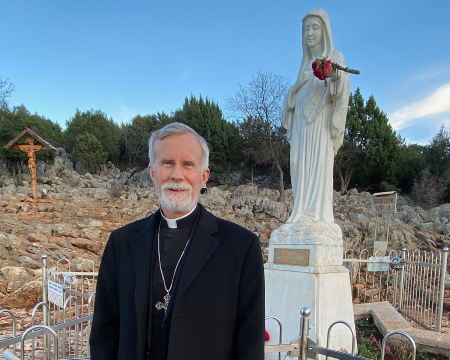Liturgy: Masses in Honor of the Blessed
FREE Catholic Classes
And More on Rose-Colored Vestments
ROME, DEC. 23, 2004 (Zenit) - Answered by Father Edward McNamara, professor of liturgy at the Regina Apostolorum Pontifical University.
Q: Please kindly give the norms which govern celebrating Masses in honor of "beati," e.g. Blessed Juniper Serra, Blessed Mr. and Mrs. Quattrocchi, or Blessed Mother Teresa of Calcutta. -- T.C., Buffalo, New York
A: The most recent norms relating to this theme are contained in a Notification published by the Congregation for Divine Worship and the Sacraments, on Sept. 20, 1997.
These update and complement the norms given in the general calendar and the more-detailed norms given in the instruction "Calendaria Particularia" issued June 24, 1970.
This document touches on the subject of inserting the blessed in local calendars in several places, but above all in Nos. 25-37.
In general, the document warns against the excessive multiplication of celebrations in order to keep the General Roman Calendar's basic unity intact.
Especially in the first years after beatification or canonization it is probably better to limit the celebration to the locales more intimately united to the saint's life before seeking permission to include a new saint or blessed in a diocesan, regional or national calendar or in a religious order's general calendar (Nos. 28, 30).
We ask you, humbly: don't scroll away.
Hi readers, it seems you use Catholic Online a lot; that's great! It's a little awkward to ask, but we need your help. If you have already donated, we sincerely thank you. We're not salespeople, but we depend on donations averaging $14.76 and fewer than 1% of readers give. If you donate just $5.00, the price of your coffee, Catholic Online School could keep thriving. Thank you.Help Now >
The celebration of a blessed differs from that of a saint above all with respect to the universality of the veneration that may be offered to them.
The blessed are usually venerated with celebrations on a local level in places where they were born, where they died, where their relics are preserved. They are also venerated in places that had a long-term association with their activities, in a church dedicated to them, or within the confines of the churches and oratories of a particular religious order which has its own liturgical calendar.
However, even in these cases, it is better to begin by inserting this celebration as an optional memorial and later expand, both territorially and in liturgical ranking as devotion spreads (No. 31).
In some cases, especially in ancient dioceses, it might even be better to restrict this initial veneration to the church where his relics are kept or to his native town.
A priest may celebrate a saint's feast day anywhere in the universal Church as an optional memorial even if this feast is not included in the general calendar.
However, he must respect the general liturgical norms regarding the precedence of different celebrations which means that such a celebration may only take place on days where there is no other feast or obligatory memorial during ordinary time, in the weekdays of Advent before Dec. 17, those of Christmas after Jan. 2 and during Eastertide after the Easter octave (No. 33).
In order to include the celebration of a blessed in the national or diocesan calendar, or to dedicate a church to a blessed, either the bishops' conference or the local bishop, as the case may be, requests permission from the Holy See.
The inclusion of a new saint or blessed into a national calendar requires a two-thirds majority of the country's bishops in a secret ballot and the recognition of the Holy See.
Once the Holy See has granted permission, the blessed may be included in the national, regional, diocesan or religious order calendar according to the liturgical ranking permitted.
A blessed is usually accorded the ranking of optional memorial, occasionally an obligatory memorial, rarely a feast (and even then usually restricted to a church containing relics), but never a solemnity.
Thus, in the examples you pointed out: A priest in the United States can celebrate Blessed Junipero Serra who has been included in the calendar of the United States. But a priest in Rome may not celebrate except, I think, within the North American College, which, like all of Rome's national colleges, is permitted to follow the home calendar.
A priest may not celebrate Blessed Mother Teresa in ordinary churches unless the Holy See has granted permission to include the celebration in the diocesan regional or national calendar. But her feast may be celebrated anywhere in the world within the chapels and oratories of the Missionaries of Charity.
* * *
Follow-up: Rose-Colored Vestments on Guadete Sunday
Our column on the use of rose-colored vestments (Dec. 7) generated a broad spectrum of colorful responses.
Some readers asked for a more exact description of these liturgical colors as some priests appeared to confuse blue with violet and pink with rose.
Although aware of the hazardous nature of attempting to describe colors with words, we will try to satisfy our readers.
Violet ("violaceus") is a hue similar to that of the synonymous flower and is defined by the Collins dictionary as "any of a group of colors that vary in saturation but have the same purplish-blue hue. They lie at one end of the visible spectrum, next to blue" -- actually, next to indigo -- "approximate wavelength range 445-390 nanometers."
Purple is a similar color and comprises "any of various colors with a hue lying between red and blue and often highly saturated; a nonspectral color."
Therefore, while various shades of purple and violet may be legitimately used, neither purple nor violet is blue, and blue vestments, except for those countries and religious orders with special privileges mentioned in our earlier response, have been explicitly forbidden in all of the color's different shades such as turquoise, azure, etc. (Decrees of the Sacred Congregation of Rites 2704, 2788).
In seems that some places distinguish between Advent ant Lent by varying the tones of purple and violet used in each season.
While such a distinction is not required by any liturgical law, there is no norm which would oppose it and the practice may be considered legitimate.
Rose ("rosaceo") is defined by the dictionary as "a. a moderate purplish-red color; purplish pink."
The liturgical color is thus a lightened violet and is darker than the pale hue usually associated with pink. It is rather a tincture closer to that of a pale incarnadine or the reddish "Naples yellow" used by artists.
Pink, "any of a group of colors with a reddish hue that are of low to moderate saturation and can usually reflect or transmit a large amount of light; a pale reddish tint," is not counted among the liturgical colors.
Contact
Catholic Online
https://www.catholic.org
CA, US
Catholic Online - Publisher, 661 869-1000
info@yourcatholicvoice.org
Keywords
Liturgy, Mass, Blessed, Saints, Vestments
More Catholic PRWire
Showing 1 - 50 of 4,716
A Recession Antidote
Randy Hain
Monaco & The Vatican: Monaco's Grace Kelly Exhibit to Rome--A Review of Monegasque-Holy See Diplomatic History
Dna. Maria St. Catherine Sharpe, t.o.s.m., T.O.SS.T.
The Why of Jesus' Death: A Pauline Perspective
Jerom Paul
A Royal Betrayal: Catholic Monaco Liberalizes Abortion
Dna. Maria St.Catherine De Grace Sharpe, t.o.s.m., T.O.SS.T.
Embrace every moment as sacred time
Mary Regina Morrell
My Dad
JoMarie Grinkiewicz
Letting go is simple wisdom with divine potential
Mary Regina Morrell
Father Lombardi's Address on Catholic Media
Catholic Online
Pope's Words to Pontifical Latin American College
Catholic Online
Prelate: Genetics Needs a Conscience
Catholic Online
State Aid for Catholic Schools: Help or Hindrance?
Catholic Online
Scorsese Planning Movie on Japanese Martyrs
Catholic Online
2 Nuns Kidnapped in Kenya Set Free
Catholic Online
Holy See-Israel Negotiation Moves Forward
Catholic Online
Franchising to Evangelize
Catholic Online
Catholics Decry Anti-Christianity in Israel
Catholic Online
Pope and Gordon Brown Meet About Development Aid
Catholic Online
Pontiff Backs Latin America's Continental Mission
Catholic Online
Cardinal Warns Against Anti-Catholic Education
Catholic Online
Full Circle
Robert Gieb
Three words to a deeper faith
Paul Sposite
Relections for Lent 2009
chris anthony
Wisdom lies beyond the surface of life
Mary Regina Morrell
World Food Program Director on Lent
Catholic Online
Moral Clarity
DAN SHEA
Pope's Lenten Message for 2009
Catholic Online
A Prayer for Monaco: Remembering the Faith Legacy of Prince Rainier III & Princess Grace and Contemplating the Moral Challenges of Prince Albert II
Dna. Maria St. Catherine Sharpe
Keeping a Lid on Permissiveness
Sally Connolly
Glimpse of Me
Sarah Reinhard
The 3 stages of life
Michele Szekely
Sex and the Married Woman
Cheryl Dickow
A Catholic Woman Returns to the Church
Cheryl Dickow
Modernity & Morality
Dan Shea
Just a Minute
Sarah Reinhard
Catholic identity ... triumphant reemergence!
Hugh McNichol
Edging God Out
Paul Sposite
Burying a St. Joseph Statue
Cheryl Dickow
George Bush Speaks on Papal Visit
Catholic Online
Sometimes moving forward means moving the canoe
Mary Regina Morrell
Action Changes Things: Teaching our Kids about Community Service
Lisa Hendey
Easter... A Way of Life
Paul Spoisite
Papal initiative...peace and harmony!
Hugh McNichol
Proclaim the mysteries of the Resurrection!
Hugh McNichol
Jerusalem Patriarch's Easter Message
Catholic Online
Good Friday Sermon of Father Cantalamessa
Catholic Online
Papal Address at the End of the Way of the Cross
Catholic Online
Cardinal Zen's Meditations for Via Crucis
Catholic Online
Interview With Vatican Aide on Jewish-Catholic Relations
Catholic Online
Pope Benedict XVI On the Easter Triduum
Catholic Online
Holy Saturday...anticipation!
Hugh McNichol












 Daily Readings for Saturday, April 20, 2024
Daily Readings for Saturday, April 20, 2024 St. Marian: Saint of the Day for Saturday, April 20, 2024
St. Marian: Saint of the Day for Saturday, April 20, 2024 Children's Prayer For Parents: Prayer of the Day for Saturday, April 20, 2024
Children's Prayer For Parents: Prayer of the Day for Saturday, April 20, 2024


